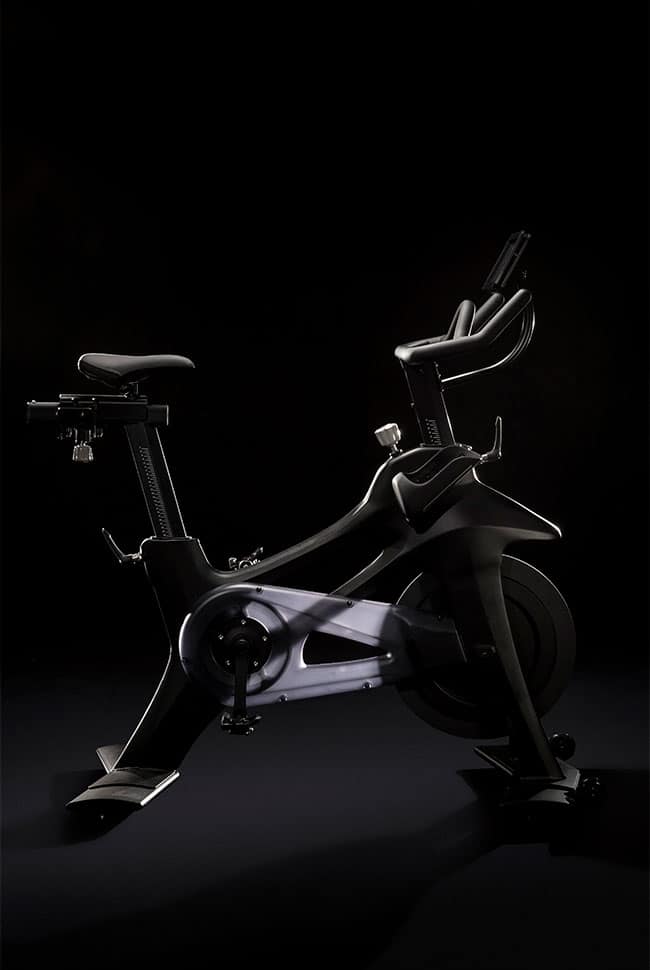SoulCycle, Peloton and Studio Three are the most popular indoor cycling studios across the country. Each ride and class appeals to a slightly different audience, yet they all have two things in common: Each workout takes place (mostly) on an indoor bike, and each of those bikes was designed by one man, Eric Villency. The self-described active individual was approached about eight years ago to design SoulCycle’s first proprietary bike, and since then has also created Peloton’s and most recently, Studio Three’s. The little details we’ve come to expect from an indoor cycling bike all started with one man.
“I’ve always been really into wellness and fitness, but focused primarily on the interior and prop design,” Villency says. “SoulCycle was a tenant in the boutique mall I built, and that was the entry into it. They were interested in product development and asked if I knew anyone. I said, ‘Well actually, we can do it.’ And that was the genesis of how that worked.” Once Villency had the in with SoulCycle, the brand trusted him. He was also a user at the time, so he understood what the brand was looking to design. After the SoulCycle design completed, word spread and more fitness studios wanted to work with Villency and his team on other ideas they had — including Peloton.

When Villency first started with Peloton, the brand was focused primarily on the tech side of things, and brought him in to focus on the hardware. “They didn’t even have a logo yet,” he recalls. “Our design team brings our own experience [to the table], we’re huge fans of fitness and live it,” Villency explains, which is why it was easy enough for the brand to produce another bike in an entirely different fashion than the first.
When you look at both the Peloton and SoulCycle bikes, you’re looking at two very different designs. “They’re all different, and we never want to repeat ourselves, which is the fun part of each project,” Villency says. But it goes beyond just the skin of the exterior. Especially with bikes, there are different handlebars, seats and sweat guards. “If you look at the SoulCycle bike that was originally out there, it was a great bike at the time, but it has manual resistance with brake pads, and now everyone does magnetic resistance. It was also the first bike to put the weights behind the seat and use an outdoor seat on an indoor bike.”
And as you might guess, both brands have expanded tremendously, taking their proprietary bikes and thrusting them into the spotlight. “We were always getting calls. ‘Hey, can I buy a Peloton or SoulCycle bike?’ [our answer was] ‘Well, no,’” Villency explains. “We make them for the brands.” Eventually, after all the phone calls, the team decided it was time to make a Villency-designed bike, sold by VDG. “We’d love to make a bike that is our design, and also can be customizable for brands.” Think of all the smaller studios that are happy with just one to two locations, but don’t want to have to deal with a stock bike for eternity.

The team paired up with Studio Three, based in Chicago, to create a new bike that will also be sold to a variety of different brands. “We’re launching [the new bike] with Studio Three, but it’s something made for multiple brands that can be skinned differently so that the consumer might not realize it’s the same platform. Cosmetics are changeable, but the basic underlying great frame is still there.” With the power to sell this bike to more than just one studio, the VDG went all-in and pulled a lot of design cues from road bikes. “One of the most inspiring things, no matter what we’re working on, is outdoor bikes. They’re gorgeous, carbon fiber, they’re on our mood and inspiration boards. So we said, how do we bring that outdoor, indoor?”
Beyond the functional limitations that an indoor bike has, it needs a stable platform. Similar to an outdoor bike, the team created a split frame. Typically, this type of design is expensive because the mechanical engineering behind it has to be durable. Some clients or brands might not want to spend the money associated with that level of engineering. “Since it’s our project, we invested in it and created it. We wanted to get as close as we could to an outdoor bike.”
After the frame change, the team looked to the service team to hear what was breaking the most, or what studios were calling about to get fixed. After all, “no one likes a bike that’s broken,” Villency says. Getting on the bike, you can feel just how stable the base of it is. While you can still wheel it around, it’s one of the heaviest out there at over 300 pounds. The water bottle holders were the other faulty piece of previous bikes. People stuff as many personal items into those as they possibly can, and it’s one of the first parts of a bike to break. “We created something that’s super flexible and can hold a weight.” They’re rubberized, so you can hang what you want on it as well. Slight design tweaks have created what might be the best new indoor bike on the market. And now it’ll be sold across the country to boutique studios everywhere.




